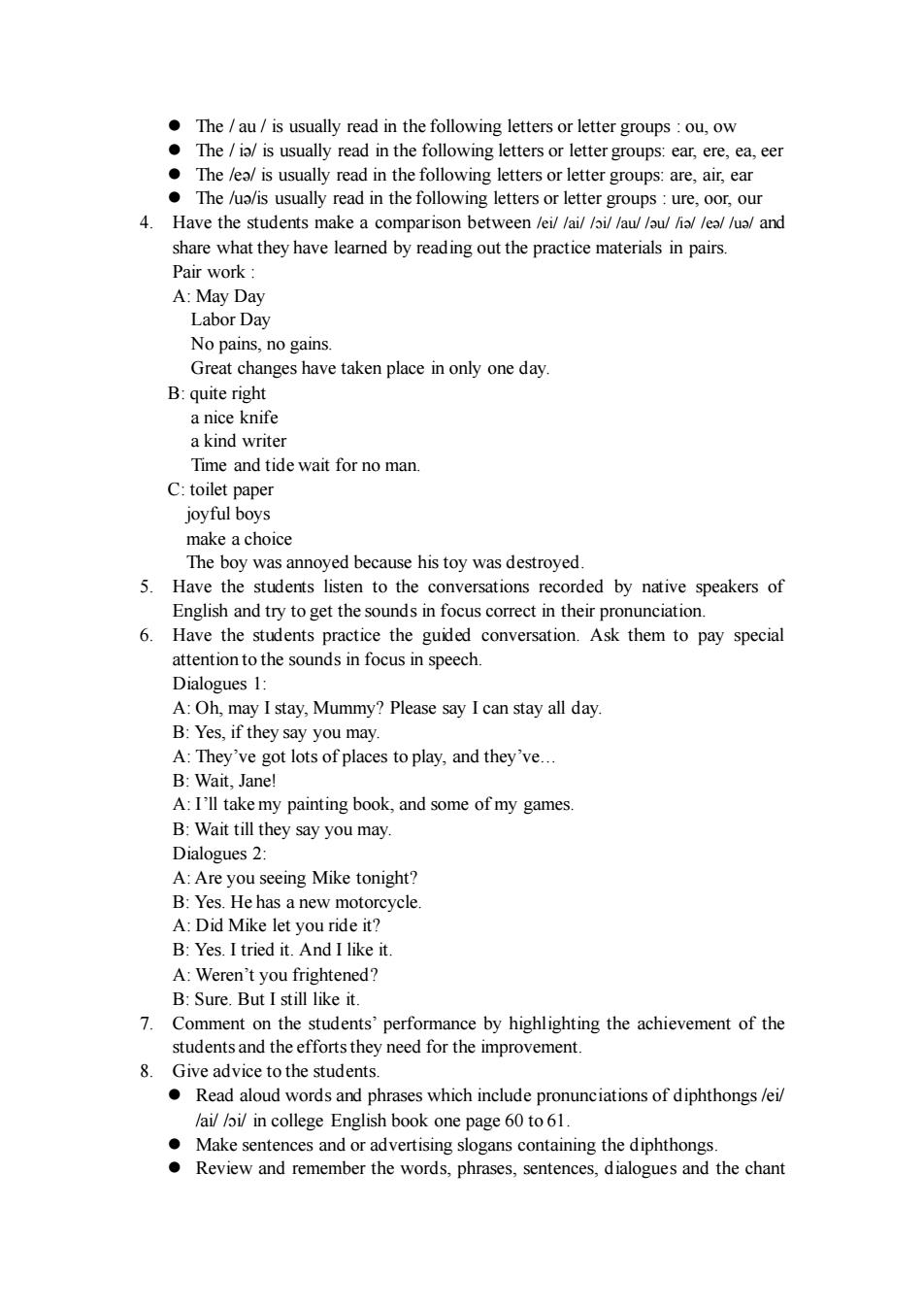正在加载图片...

The /au/is usually read in the following letters or letter groups:ou,ow ●The/iai s usually read in the following lettersor letter groups:ear,ere,ea,eer usually read in the foll lowing letters or letter groups:are,air,ear The /u/is usually read in the following letters or letter groups:ure.oor.our 4.Have the students make a comparison between /eil /ai//i//au//au/fial /ea//ua/and share what they have learned by reading out the practice materials in pairs. Pair work A:May Day Labor Day No pains.no gains. Great changes have taken place in only one day B:quite right a nice knife a kind writer Time and tide wait for no man C:toilet paper joyful boys 5.Have the students listen to the conversations recorded by native speakers of English and try to get the sounds in focus correct in their pronunciation. 6.Have the students practice the guided conversation.Ask them to pay special attention to the sounds in focus in speech. logues 1: A:Oh,may I stay,Mummy?Please say I can stay all day. B:Yes.if they say you may. A:They've got lots of places to play,and they've. B:Wait Janel A:I'll take my painting book,and some of my games B:Wait till they say you may. Dialogues 2 A:Are you seeing Mike tonight? B:Yes.He has a new motorcycle A:Did Mike let you ride it? B:Yes.I tried it.And Ilik A:Weren't you frightened? B:Sure.But I still like it. 7.Comment on the students'performance by highlighting the achievement of the students and the efforts they need for the improvement. 8. advice to the students Read aloud words and phrases which include pronunciations of diphthongs/i fai//i/in college English book one page 60 to 61. Make sentences and or advertising slogans containing the diphthongs. Review and remember the words,phrases,sentences,dialogues and the chant ⚫ The / au / is usually read in the following letters or letter groups : ou, ow ⚫ The / iә/ is usually read in the following letters or letter groups: ear, ere, ea, eer ⚫ The /eә/ is usually read in the following letters or letter groups: are, air, ear ⚫ The /uә/is usually read in the following letters or letter groups : ure, oor, our 4. Have the students make a comparison between /ei/ /ai/ /ɔi/ /au/ /әu/ /iә/ /eә/ /uә/ and share what they have learned by reading out the practice materials in pairs. Pair work : A: May Day Labor Day No pains, no gains. Great changes have taken place in only one day. B: quite right a nice knife a kind writer Time and tide wait for no man. C: toilet paper joyful boys make a choice The boy was annoyed because his toy was destroyed. 5. Have the students listen to the conversations recorded by native speakers of English and try to get the sounds in focus correct in their pronunciation. 6. Have the students practice the guided conversation. Ask them to pay special attention to the sounds in focus in speech. Dialogues 1: A: Oh, may I stay, Mummy? Please say I can stay all day. B: Yes, if they say you may. A: They’ve got lots of places to play, and they’ve. B: Wait, Jane! A: I’ll take my painting book, and some of my games. B: Wait till they say you may. Dialogues 2: A: Are you seeing Mike tonight? B: Yes. He has a new motorcycle. A: Did Mike let you ride it? B: Yes. I tried it. And I like it. A: Weren’t you frightened? B: Sure. But I still like it. 7. Comment on the students’ performance by highlighting the achievement of the students and the efforts they need for the improvement. 8. Give advice to the students. ⚫ Read aloud words and phrases which include pronunciations of diphthongs /ei/ /ai/ /ɔi/ in college English book one page 60 to 61. ⚫ Make sentences and or advertising slogans containing the diphthongs. ⚫ Review and remember the words, phrases, sentences, dialogues and the chant